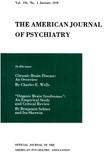BILATERAL INTERNAL JUGULAR BLOOD
Abstract
Blood was drawn simultaneously from an artery and the two internal jugular veins in 25 subjects.
The oxygen A-V difference was approximately the same on the two sides, except in 4 patients with psychosis, and in 4 epileptics with left-sided cerebral pathology. In the latter the oxygen A-V difference on the affected side was relatively great, suggesting a diminished blood flow.
In all but 3 of the 25 cases the respiratory quotient approached unity, the average in these 22 being .995 on the right side and .994 on the left side. Variations in the A-V differences in oxygen, as between both individuals and the two sides, did not cause a shift in the value of the respiratory quotient. The average ratio of the A-V difference of oxygen (in volumes percent) to the A-V difference of glucose (in milligrams percent) was equal, 1.63 on the right side and 1.62 on the left.
In 7 cases hyperpnea produced the usual increase in the oxygen A-V difference, with-out consistent differences on the two sides, even in the presence of unilateral brain pathology.
Simultaneous puncture of the jugulars and artery is not necessary if A-V differences in the oxygen content of the blood are being measured, but it is necessary if the carbon dioxide content, the respiratory quotient, or the oxygen-glucose ratios are being measured.
Access content
To read the fulltext, please use one of the options below to sign in or purchase access.- Personal login
- Institutional Login
- Sign in via OpenAthens
- Register for access
-
Please login/register if you wish to pair your device and check access availability.
Not a subscriber?
PsychiatryOnline subscription options offer access to the DSM-5 library, books, journals, CME, and patient resources. This all-in-one virtual library provides psychiatrists and mental health professionals with key resources for diagnosis, treatment, research, and professional development.
Need more help? PsychiatryOnline Customer Service may be reached by emailing [email protected] or by calling 800-368-5777 (in the U.S.) or 703-907-7322 (outside the U.S.).



